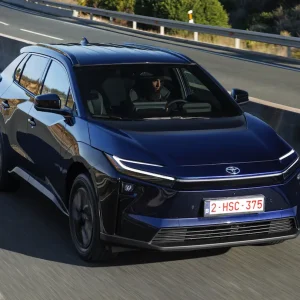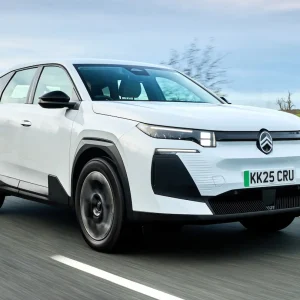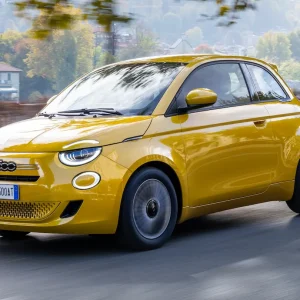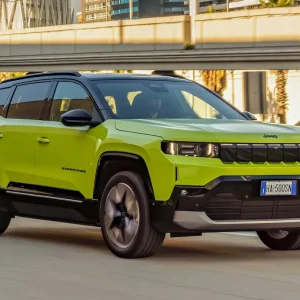Supply chain shortages are never far from our headlines these days and you have to think Toyota is suffering more than most, as it has run out of Rav4 badges and is having to make do with Yaris emblems instead.
How else do you explain why the Yaris Cross looks so much like a mini-me version of the Rav4 and bears so little resemblance to the Yaris supermini it is based on?
Alternatively, it could be that although the Yaris is a striking looking city gadabout, translating its feisty styling into a credible-looking SUV format proved to be a design stretch too far. And, in a sector dominated by cars like the Nissan Juke, Renault Captur, Citroen C3 Aircross and Ford Puma, quite clearly, design is king.
This kind of bespoke exterior panelling doesn’t come cheap and you have to think that once the body was signed off there wasn’t much left in the pot to sort out the interior.
Although everything looks and feels solid inside, and being a Toyota, it will most probably remain squeak and rattle-free for decades to come, there’s not a lot to get excited about.
Being brutally honest, the banal layout and acres of black plastics are positively yawnful, especially when set against the riot of swish panels and eye-candy features you’ll find in a Nissan Juke.
At least the graphics displayed in the centrally mounted screen are more contemporary and their responses are far more urgent than in many previous Toyota models.
There’s also a decent amount of interior space, primarily because the Cross is a good deal longer, taller and wider than its supermini donor.
On top of this, there’s a useful boot that comes with a height-adjustable floorboard on higher-spec models, which can be employed to create a hidden basement storage area or used to level up the load bay floor when the rear seat backs are folded. While we’re on the subject, a special shout out goes to the genius who suggested sticking rubberised material on to the folding rear seatbacks, meaning dog hairs and associated slobbering can be expunged with a quick swish of a damp cloth.
It comes as no surprise that the Yaris Cross is powered by a hybrid powertrain and this particular example is one of the best versions of the technology.
Its cause is aided by the fact that the Cross is a relatively light car and combined with the strong torque development from the combination of the 1.5-litre three-cylinder petrol engine and 59kW electric motor, it has little trouble keeping the inherent slippy nature of its CVT automatic gearbox under control. Consequently, it’s an infinitely smoother propulsion unit than the 1.0 turbo engine and jerky DSG twin-clutch combo you’ll find in a Juke.
Unfortunately, powertrains transitions from electric to petrol-electric propulsion aren’t entirely flawless, as the three-cylinder’s engine’s eccentric firing stumble when bumped into life tends to transmit a fair few shudders into the cabin.
Even when you call for absolute flat-out acceleration though, the engine revs never sound that intrusive and the performance feels a fair bit nippier than the bald sprint figures suggest. You’ll enjoy that vigour all the more given the Cross stops as well as it goes, thanks to reassuringly strong brakes and a wholesome feeling brake pedal.
Its also a pleasingly refined car. As well as doing an excellent job of blotting out wind and road noise, the suspension is more than capable of coping with the patchwork arrangement of bish-bash-bosh surfaces that pass for our urban landscapes.
The only downside to this comfort is relatively high levels of bonnet rise and fall associated with hard acceleration and braking, but overall, body sway is well controlled, so you’ll need to be cornering in a pretty ‘spirited’ manner before you hear any complaints from the tyres.
Although tax implications for hybrids seem less attractive with each more punitive tax year, fuel consumption and CO2 outputs are still very encouraging compared with rivals using more traditional powertrains. While 50-plus mpg should be easily attainable depending on wheel size, CO2 outputs range from as little as 100g/km for the entry-level front-wheel-drive version, climbing to 115g/km for the 4WD model. This translates into a BIK implication of 24% for the FWD car and 27% for the 4WD model.
Overall then, the Rav Cross, sorry, Yaris Cross, is a bit of a dazzler. Augmented by extensive comfort and safety features, its standard auto gearbox, comfortable driving manners and on-trend looks are sure to win many admirers. It’s just a shame that some of that sparkle didn’t rub off on the interior.
Toyota Yaris Cross Hybrid Design
P11D: £23,935
Residual value: 39.2%
Depreciation: £14,546
Fuel: £5,780
Service, maintenance and repair: £2,217
Cost per mile: 37.57p
Fuel consumption: 62.8 mpg
CO2 (BIK %): 103g/km (24%)
BIK 20/40% a month: £96/£191
Luggage capacity: 397 litres
Engine size/power: 1490cc/91hp plus 80hp electric motor





